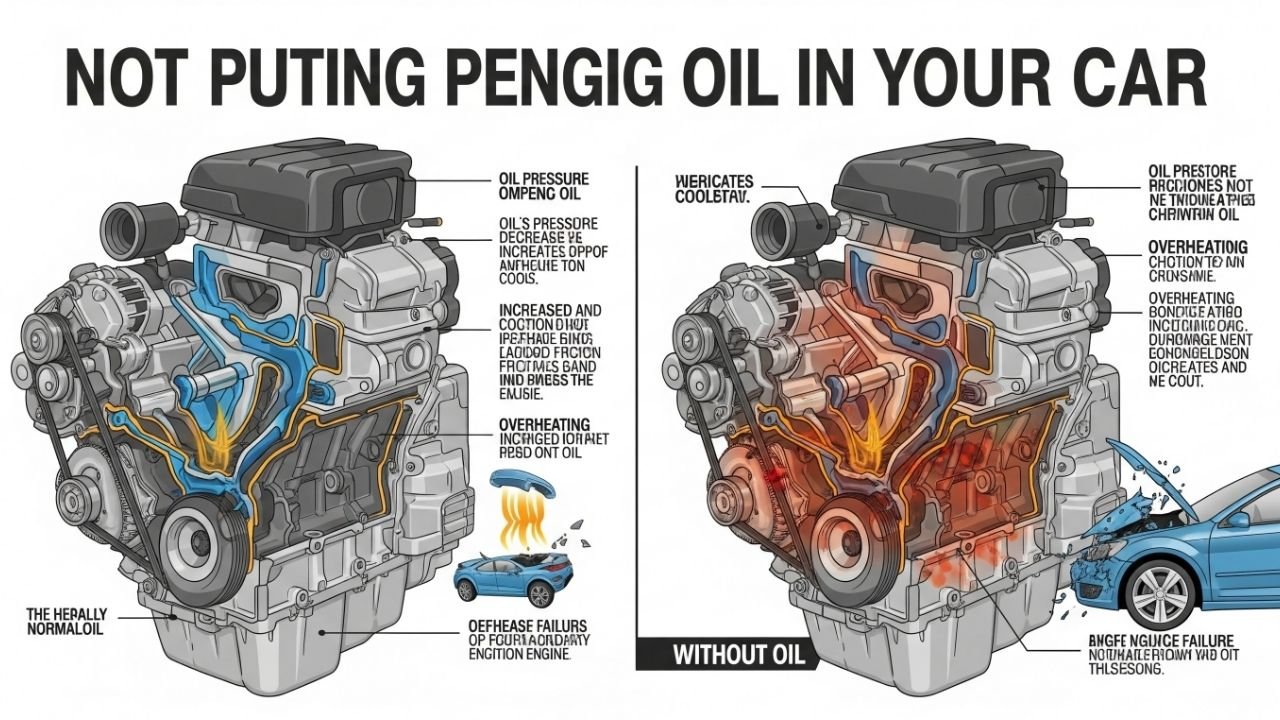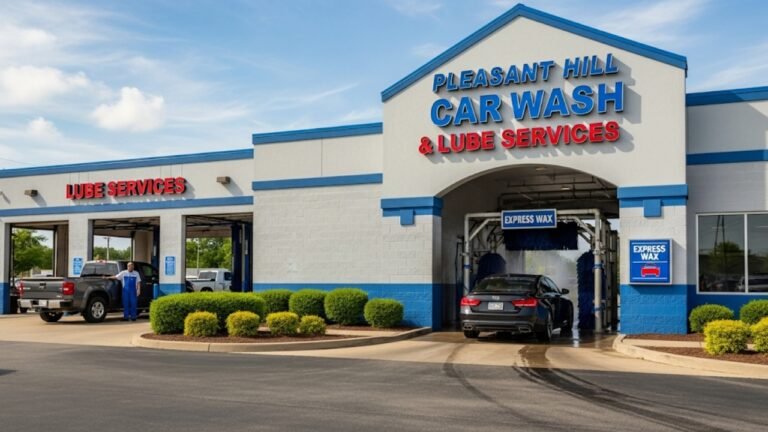What Happens If You Don’t Put Oil in Your Car?

We’ve all done it—missed an oil change by a few weeks, maybe even months. Life gets busy, and sometimes car maintenance takes a backseat. But have you ever wondered, what happens if you don’t put oil in your car at all? Spoiler alert: It’s not pretty.
Think of motor oil as the lifeblood of your engine. Without it, your car’s internal parts grind against each other, heat up, and break down—fast. In this guide, we’ll explore the real-world effects of ignoring your car’s need for oil, with insights drawn from both mechanical facts and relatable experiences.
I once drove my cousin’s old Honda Civic that hadn’t had an oil change in over a year. Let’s just say, the knocking sound coming from the engine told me more than I wanted to know. What followed was a costly lesson—one I hope you can avoid.
In this article, we’ll break it all down in simple, digestible language. Short paragraphs, easy words, but deep insight—because this isn’t just about cars. It’s about responsibility.
What Motor Oil Actually Does for Your Car
Before we dive into the horrors of skipping oil, let’s look at why it’s so important. Motor oil is a multitasker. It lubricates, cools, cleans, and protects your engine’s moving parts. Imagine running a marathon in 100°F heat with no water. That’s your engine without oil.
Here’s how oil helps your car stay alive:
- Lubrication: Prevents metal parts from grinding.
- Cooling: Reduces heat caused by friction.
- Cleaning: Carries away dirt and debris.
- Sealing: Keeps components tightly sealed.
- Protecting: Prevents rust and corrosion.
So when you ignore it, you’re basically leaving your engine high and dry.
The Clock Starts Ticking: What Happens the Moment Oil Runs Out
The moment your car runs without oil, damage starts creeping in. It might not show up right away, but it’s happening under the hood.
In the first few minutes:
- The oil warning light might blink on—ignore it, and the countdown begins.
- Metal components start grinding—like gears in a blender with no fluid.
- Heat rises fast—friction has no filter anymore.
Within 10 to 15 minutes, parts that usually glide start to scrape and wear. Without oil, your engine is literally tearing itself apart. I’ve seen this happen firsthand in a friend’s old Toyota Corolla. He kept saying, “I’ll get an oil change next weekend.” That weekend never came. A week later? Engine seized.
Engine Damage: When the Heart of Your Car Gives Out
The engine is the heart of your car, and oil is the heartbeat. No oil? No pulse. Here’s what can go wrong:
- Rod Knock: This sounds like a hammer tapping from inside the engine. It’s a sign that internal rods are hitting the crankshaft due to lack of lubrication.
- Overheating: Your engine temperature spikes, often causing the head gasket to blow.
- Engine Seizure: When the pistons weld to the cylinder walls, the engine completely locks up.
Let’s put this in a simple table:
| Damage Type | Cause | Outcome |
|---|---|---|
| Rod Knock | No oil between rods and crankshaft | Loud knocking sound |
| Overheating | No cooling effect from oil | Blown head gasket, warped engine |
| Seized Engine | Friction welding pistons in place | Complete engine failure |
By this point, you’re not just looking at a small fix. You’re looking at a full engine replacement—often costing thousands.
Real-Life Consequences: A Price You Didn’t Expect
I remember talking to a mechanic who said, “Most people don’t realize their engine died from no oil until it’s too late.” It’s like getting dehydrated in the desert—you don’t feel it until your body starts shutting down.
Let me share the story of Omar, a college student I met through a car forum. He drove his dad’s hand-me-down Ford Focus, ignored every oil light, and kept putting it off. Eventually, the car just stopped on the highway. Total engine failure. The tow truck guy said, “You might as well buy a new car.”
Omar spent $3,200 on repairs. That’s money he didn’t have—and all because he didn’t spend $50 on an oil change. Sounds harsh, but it’s the truth.
Long-Term Risks That Linger Even After a Refill
Let’s say you run low on oil but manage to top it off before the engine seizes. Crisis averted, right? Not quite.
Running on low oil—even for a short time—leaves scars:
- Scored pistons and cylinder walls.
- Burnt valves and seals.
- Oil sludge buildup from burnt remnants.
These don’t go away just because you added more oil. It’s like scraping your skin badly and thinking it’s healed just because you put a band-aid on. The damage is still underneath.
Signs You’ve Waited Too Long: Don’t Ignore These Red Flags
Wondering if you’re already in the danger zone? Watch for these warning signs:
- Knocking or ticking noises from the engine.
- Burning smell or smoke from the hood.
- Loss of power while accelerating.
- The dreaded oil pressure light flickering or staying on.
If any of these happen, stop driving immediately. Driving further only makes it worse. I’ve known people who ignored the ticking sound thinking it was “just cold weather.” Spoiler: It wasn’t.
Bullet Recap: What You Risk Without Engine Oil
Here’s a quick list of what you’re gambling with:
- Engine overheating
- Rod bearing failure
- Crankshaft damage
- Head gasket blowout
- Complete engine seizure
- Thousands in repair bills
- Potentially totaling your car
And all of it because you didn’t add motor oil.
Why Some People Still Skip Oil Changes (And Why You Shouldn’t)
It’s easy to forget, especially when modern cars run smoothly for weeks without issues. Plus, with all the tech dashboards and sensors, we assume the car will “tell us” before things get bad.
But those alerts aren’t always fast enough. By the time the oil light turns on, damage may have already begun. That’s why preventive care is better than damage control.
How to Prevent Oil Trouble: Stay Ahead, Not Behind
The good news? All of this engine damage is 100% preventable with just a little effort. You don’t need to be a car expert or own fancy tools. Just a basic routine and a bit of attention can save your engine—and your wallet.
Here’s how to stay in control:
- Check your oil level monthly: Use the dipstick. Wipe it clean, dip it again, and check if the oil level is between the “Min” and “Max” marks.
- Follow your car’s oil change schedule: Check the manual or stick to the general rule—every 3,000 to 5,000 miles for conventional oil, or 7,500 to 10,000 miles for synthetic oil.
- Look under the car for leaks: A few dark spots in the driveway can mean a slow leak. Don’t ignore them.
- Watch your dashboard lights: The oil pressure light isn’t decorative—it’s a warning.
- Listen for engine sounds: Unusual knocking or clicking? That’s your car whispering, “Please check my oil.”
Taking 10 minutes once a month is better than facing $5,000+ in engine repairs later.
The Role of Synthetic Oil: Better Protection, Longer Life
If you’re like me and sometimes forget maintenance tasks, synthetic oil might be your best friend. It lasts longer, resists breakdown under heat, and keeps your engine cleaner.
Let’s compare the two in a quick table:
| Oil Type | Change Interval | Durability | Cost per Change |
|---|---|---|---|
| Conventional Oil | 3,000–5,000 miles | Breaks down faster | $30–$50 |
| Synthetic Oil | 7,500–10,000 miles | More stable & durable | $60–$100 |
While synthetic oil costs more upfront, it offers long-term peace of mind, especially for people who tend to forget oil changes.
Don’t Wait for Symptoms: Use a Simple Reminder System
In our busy lives, reminders can be lifesavers. Set one on your phone or use sticky notes on your dashboard. Or better yet:
- Use a maintenance tracking app like Carfax Car Care or Simply Auto.
- Ask your mechanic to put a mileage sticker on your windshield.
- Tie oil changes to life events: Birthday? Oil change. New season? Oil change.
Create a habit that sticks—and stick to it like your car depends on it (because it does).
Emotional Angle: This Isn’t Just About Oil—It’s About Care
You wouldn’t let your phone die every day because you forgot to charge it, right? Your car deserves the same care. Not because it’s a machine, but because it carries you through life—work, family trips, emergencies, memories.
I still remember when my dad gave me his old Mazda. He told me, “It’s not about horsepower. It’s about heart. Take care of it, and it’ll take care of you.” That advice stuck with me, and I pass it on to you.
Caring for your car is more than maintenance. It’s respect for what keeps your life moving.
Frequently Asked Questions (FAQs)
1. How long can a car run without oil?
Not long at all. Most engines will start suffering damage within 5–10 minutes of running with no oil. Some may seize entirely in under 30 minutes. Don’t push it.
2. What does the oil warning light really mean?
It means your engine is low on oil pressure. Either there’s not enough oil, the oil pump isn’t working, or the sensor is faulty. Regardless, stop the car and check the oil immediately.
3. Can I just top off the oil instead of changing it?
Topping off is okay occasionally in an emergency, but it doesn’t remove old, dirty oil or contaminants. You still need regular oil changes.
4. What happens if the oil is old but still full?
Old oil loses its viscosity and turns into sludge. Even if the dipstick reads “Full,” dirty oil can’t protect your engine.
5. Will my car start if there’s no oil?
Yes, it might start—but that’s the problem. It’ll run just long enough to destroy itself. Starting the engine with no oil is like jumping into a volcano because it looks warm.
6. Can synthetic oil prevent engine damage if I forget to change it?
It resists breakdown better, but no oil lasts forever. Even synthetic oil eventually degrades. Skipping changes still risks your engine.
7. How do I know what oil my car takes?
Check your owner’s manual or look at the oil cap on your engine. It usually says something like “5W-30.” Use exactly what’s recommended.
8. Is it safe to drive with the oil light on for a few days?
No. That’s like driving with no brakes and hoping nothing stops in front of you. If the oil light is on, your engine is at serious risk.
Final Thoughts: Your Car is Counting on You
Let’s bring it home. We’ve covered a lot—but it all boils down to this: Don’t skip oil. Your car isn’t trying to make your life harder. It’s doing its best to take you where you need to go. But like any relationship, it needs attention.
When you ignore oil maintenance, you’re not just risking metal and bolts. You’re risking:
- Your time
- Your money
- Your safety
- Your peace of mind
So the next time you see that little oil can icon blink on your dashboard, don’t treat it like a low-priority task. Treat it like a call for help—from a very hardworking friend.
Stay proactive. Stay safe. And most of all, stay oiled up.






